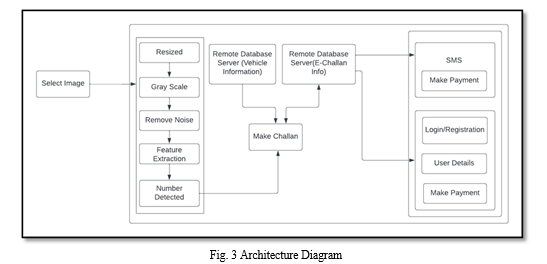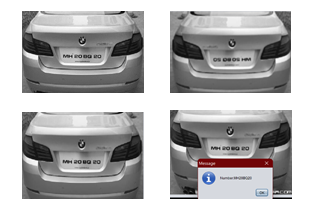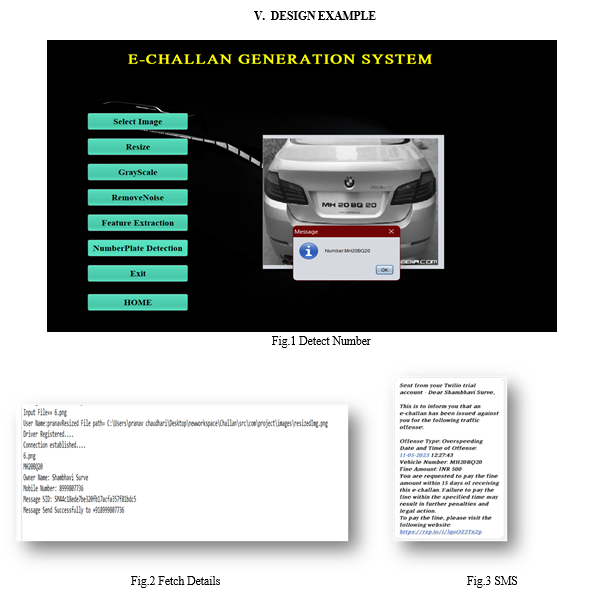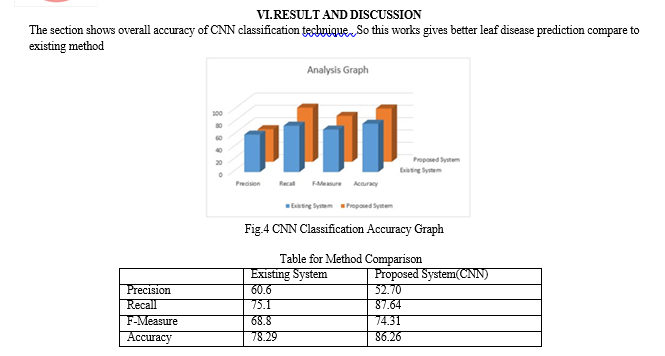Ijraset Journal For Research in Applied Science and Engineering Technology
- Home / Ijraset
- On This Page
- Abstract
- Introduction
- Conclusion
- References
- Copyright
E-Challan Generation System using ANPR with Desktop Application
Authors: Pranav Chaudhari, Rushika Chaudhari, Damini Dubey, Vaishnavi Shinde
DOI Link: https://doi.org/10.22214/ijraset.2023.52714
Certificate: View Certificate
Abstract
Efficiently overseeing adherence to traffic regulations is an arduous task faced by authorities in light of population growth and increased vehicular activity on roads. The conventional approach to managing road users who break laws involves time-intensive manual processes that interfere with smooth transportation operations. This paper proposes a promising tactic for automating the production of E-challans through incorporation of Automatic Number Plate Recognition (ANPR) technology. By installing mounted cameras with ANPR capabilities alongside CCTV equipment which utilizes image processing together with optical character recognition technology (OCR), swift automated identification of infringing drivers can be achieved through read-outs from their vehicle registration plates. Ultimately, this method seeks to lessen reliance on human resources while enhancing the effectiveness of law enforcement activities.
Introduction
I. INTRODUCTION
The escalating population has led to a substantial increase in the number of vehicles on our roads, creating a pressing need for effective solutions in managing traffic rule violations. These violations encompass a wide range of offenses, including running red lights, failure to comply with seat belt and helmet regulations, speeding, inadequate vehicle insurance, fitness, pollution control, and driver's license compliance, among others. In response to the growing disregard for traffic regulations, the concept of challan has gained significant prominence.
However, authorities face considerable challenges in tracking such infractions, identifying vehicle owners, and enforcing appropriate penalties .
To address these challenges, the implementation of an electronic challan production system with automatic number plate identification has proven to be an invaluable tool for authorities. This system enables efficient handling of traffic rule violations, while providing offenders with a streamlined method of managing their penalties through the use of E-challan.
The primary objective of this project is to develop an electronic challan system that utilizes license plate recognition technology to accurately capture passing vehicles' license plates. Subsequently, a challan will be generated and sent to the registered owner's mobile number via SMS, which is associated with the vehicle's registration number.
This process involves the use of cameras to capture images of the violating vehicles, followed by number plate detection and character segmentation performed using an Automatic Number Plate Recognition (ANPR) system. The detected number plate is then matched against the database [9].
By employing this advanced real-time machine intelligent system, the proposed solution outlined in this paper ensures precise identification of the vehicle's number plate and generates an e-challan in the registered owner's name by identifying the specific traffic violation committed.
Consequently, this automated process significantly reduces the burden of manual work for officials, simplifies the management and monitoring of challans, and ensures more effective enforcement of traffic regulations.
II. RELATED WORK
- K.T. Ilayaraja, V. Vijaykumar, M. Sugadev, T. Ravi: In this research paper, an innovative model is proposed for the identification of permit number plates using the powerful ResNet CNN network. The ground breaking system demonstrates remarkable proficiency in recognizing vehicle numbers and acquiring detailed information about vehicle ownership from the local database. It exhibits commendable accuracy even for vehicles in motion at speeds of up to 10 km/hour. The primary focus of this study revolves around the intricate domain of character recognition, which holds immense potential for further enhancement and exploration in the realm of data analytics [1].
- Shubham Kumar Chandravanshi, Hirva Bhagat, Manan Darji, Himani Trivedi: Traffic law violations are now a serious problem, and society's moral fabric is being weakened by people's casual and irresponsible attitudes. Although our country's traffic laws have greatly improved over the past few years, the human factor in our current system remains a liability and produces poor results that could have been far better. This encourages such careless drivers because it causes the delivery of paper-based and electronic challans to be delayed and occasionally inaccurate. Our proposal automates the process of identifying traffic offenders (using object detection and object tracking) ,and generating the E-challans by directly fetching the vehicle information from the RTO after extracting the number plate data (number plate detection). The E-challan is then delivered via Email and SMS on the same day the offence is registered. By doing this, the system's efficiency, accuracy, and chance of human error will all be significantly improved over what they are now[2].
- R Shreyas, Pradeep Kumar B V, Adithya H B, Padmaja B, Sunil M P: Image processing technology is the foundation of the proposed Automatic Number Plate Recognition (ANPR) system. The proposed system can be used primarily to monitor traffic-related activities on the road, including the identification of vehicles during traffic violations like excessive speed and lane violation at street traffic signals. So that we can have smooth traffic flow and also prevent accidents from happening at the traffic junction, we can track every vehicle for traffic rule violations and can provide the information to the concerned authority to take further effective action. The authorities may also utilise this technology to help them locate any stolen vehicles. The suggested system first looks for any vehicles that are breaking traffic laws before taking a picture of the offending vehicle. The region containing the vehicle number plate will be retrieved from the obtained image using image segmentation techniques. And the method employed for number plate character recognition is Character recognition using optical[3].
- Shaji Thorn Blue, M. Brindha: The suggested study aims to increase the accuracy of boundary boxes that were drawn when items were found on an image. YOLOv3 is a real-time, cutting-edge object detection solution when it comes to object detection. As a result, the suggested work improved the accuracy of the boundary boxes surrounding the object by using YOLOv3 as a basis model. The suggested work improves the precision of the border box surrounding the item using edge detection, pixel values in an area, and the pretrained COCO dataset for object detection. When compared to YOLOv3, the suggested approach greatly improves border box precision[4].
- Zhemin Liu, Weiling Chen, Chai Kiat Yeo: For end-to-end illegal parking detection, a fully automated pipeline is suggested in this study. A deep learning-based object detection system called You Only Look Once Version 3 is used to recognise vehicles quickly and robustly (YOLOv3). With built-in procedures for error tolerance, movement tracking tracks the stationary time of the vehicle-infraction using template matching and intersection over union (IoU) calculations. The licence plate is extracted using OpenALPR. According to empirical findings, licence plate capture performs very well and vehicle detection and movement tracking are highly accurate in a variety of environmental settings[5].
- Richard G, Casey, d Eric Lecolinet: rather than just listing sources, something has been developed. There are four main sections that list various segmentation techniques. The "classical" approach, as it is sometimes referred to, uses techniques to divide the input image into subimages that are then categorised. Dissection is the process of attempting to break down an image into discrete, classifiable components. The second class of approaches avoids dissection and either explicitly segments the image by categorising windows that have been predetermined or implicitly segments the image by categorising subsets of spatial information that have been gathered from the entire image. The third approach combines the first two, using classification to narrow down the pool of permissible segmentation options provided by these subimages while still applying dissection and recombination procedures to define[6]
- Bhavin V Kakani, Divyang Gandhi, Sagar Jani: The improved licence plate recognition method described in this paper makes use of a trained neural network dataset of object features. a hybrid algorithm for licence recognition To increase accuracy, a suggested plate is evaluated and contrasted with current practises. Three main modules—License Plate Localization, Plate Character Segmentation, and Plate Character Recognition—can be used to group the system as a whole. The system is tested using 300 motor vehicle LP photos from throughout the nation and the world, and the findings obtained support the primary need[7].
- Amirgaliyev Beibut, Kairanbay Magzhan, Kenshimov Chingiz: Automated number plate recognition is now available. An important factor in traffic congestion is the (ANPR) system. This will assist help reduce many forms of traffic offences. Advanced technologies for locating and identifying unlicensed, stolen cars are based on technologies for automatically identifying licence plates. The primary goals of this research are to explore various approaches and we put forth a new algorithm. There is a brief analysis of the numerous algorithms for number plate identification. Further Graphical explanations of the proposed algorithm are provided forms to demonstrate the algorithm's operation. The paper's conclusion includes exam and assessment outcomes[8].
- Muhammad Tahir Qadri, Muhammad Asif: Vehicle the image segmentation technique is used to extract the number plate region.in a picture. It uses an optical character recognition technique.to recognise the characters. . The obtained information is then utilised to compare with the entries in a database to determine the precise information, such as the owner of the car, the location where it was registered, its address, etc. Matlab is used to implement and simulate the system, and real images are used to test the system's performance. The experiment shows that the developed system can successfully find and identify the vehicle licence plate on real images[9].
- Otto Fucík, Pavel Zemík, Pavel Tupec, LudkCrha, Adam Herou: The offered device (Unicam) provides a sophisticated cutting-edge machine vision tools and the development of automatic video image vehicles detecting equipment specifically designed to monitor traffic applications. The system offers live video and picture capture, compression, and digital signal processing storage and communication over transmissioninter faces. It makes use of specialised artificial intelligence. unique image processing modules and techniques to accomplish incredibly precise vehicle detection. As stated bythe system's use for detection of the requirements of the users speeding, running red lights at junctions measuring, gathering traffic statistics, filming, or surveillance. Yet another potential use of the system uses licence plate recognition questionnaires for Transportation engineers, car theft investigation, or toll tag data gathering. , monitoring, or videotaping. Surveys using licence plate recognition for transportation engineers, the hunt for stolen vehicles, or the gathering of tolltag data are a few more potential uses for the system. By combining camera sensors with specialised real-time processing units and adding networking capabilities, the system's functionality has been enhanced. Additionally discussed are the use of hardware design units, networking features, and video detection algorithms[10].
III. PROPOSED SYSTEM

- Input Image: Here we can upload the Input numberplate Image.
- Image Pre-processing: In this step we will apply the image pre-processing methods like grey scale conversion, image noise removal.
- Gray Scale: In a grayscale image, each pixel is represented by a single intensity value ranging from black (0) to white (255), with various shades of gray in between.
- Remove Noise: Removing noise refers to the process of reducing or eliminating unwanted or irrelevant data from an image.
- Image Feature Extraction: In this step we will apply the image pixel extraction methods to remove the image features from image.

6. Challan Maker: The Challan Maker system utilizes optical character recognition (OCR) to extract characters from the number plate. These characters are then compared with the database to retrieve vehicle and owner information. The system verifies and checks the obtained details, and generates a challan .
7. Desktop Application: Users can conveniently access the Desktop application. For first-time visitors, it is necessary to create a new account. Once registered, users can log in and access their personalized dashboard. Within the dashboard, users can easily find their challan by entering their Username. They can make payments for the challans.
V. ALGORITHM
A. Optical Character Recognition (OCR)
OCR, also known as text recognition, is a program that extracts and repurposes data from scanned documents, camera images, and image-only PDFs. It identifies individual letters on the image, combines them into words, and then constructs sentences, enabling access to and editing of the original content. OCR eliminates the need for manual data entry. OCR systems utilize a combination of hardware and software to convert physical, printed documents into machine-readable text. Hardware components such as optical scanners or specialized circuit boards are used to copy or read the text, while software handles the advanced processing. With the integration of artificial intelligence (AI), OCR software can implement more sophisticated techniques for intelligent character recognition (ICR), such as identifying different languages or styles of handwriting. The OCR process is commonly employed to convert hard copy legal or historical documents into PDF format, enabling users to edit, format, and search the documents as if they were created with a word processor.
B. Convolution Neural Network (CNN)
CNN is a powerful architecture for image processing and pattern recognition. It consists of two main layers: the feature extraction layer and the feature map layer. In the feature extraction layer, each neuron's input is connected to local receptive fields in the previous layer, allowing it to extract local features. These local features capture the positional relationships between different features in the input image. The feature map layer comprises multiple computing layers, each composed of feature maps. A feature map represents a two-dimensional plane, where the weights of the neurons within the plane are the same. By utilizing the sigmoid function as the activation function in the convolution network, the feature maps exhibit distinctive shifts. Additionally, the weight sharing among neurons in the same mapping plane reduces the number of free parameters in the network.
Each convolution layer is followed by a computing layer, which is responsible for finding local averages and performing the second stage of feature extraction. This unique two-step feature extraction structure helps to decrease the resolution of the input.
C. The Convolution Layer
Is the initial layer in a CNN and plays a crucial role in extracting features from the input image, such as a leaf image. By convolving the image with different filters, the convolution layer learns image features by analyzing small squares of input data. This process allows for operations like edge detection, blur, and sharpening by applying filters such as identity filter, edge detection filter, sharpening filter, box blur filter, and Gaussian blur filter.
D. Pooling Layers
Are employed to reduce the number of parameters when dealing with large images. Spatial pooling, also known as subsampling or down sampling, decreases the dimensionality of each feature map while retaining important information. Fully connected layer takes the feature map matrix and converts it into a vector representation (x1, x2, x3, etc.). These features are combined in the fully connected layers to create a model capable of making predictions or classifying the input data.
E. Softmax Classifier
Along with activation functions such as softmax or sigmoid, is applied to classify the outputs of the model. This step is often used for tasks like leaf disease classification, where the model predicts the class or category of the input based on the extracted features.


Conclusion
Law enforcement, toll collection, vehicle theft detection, traffic regulation, and road safety, security and surveillance, as well as traffic management and monitoring, all stand to gain significant advantages from this project. One aspect that stands out is how this project streamlines the manual tasks carried out by authorities and officials, resulting in an accelerated process of inspecting and verifying vehicle details, ultimately enabling the efficient management of challans.
References
[1] K.T.Ilayarajaa, V. Vijaykumar, M.Sugadev,T.Ravi ,”Text Recognition in Moving Vehicles using Deep learning Neural Networks”IEEE Xplore Part Number: CFP21OAB-ART; ISBN: 978-1-7281-9537-7,May 2021. [2] Shubham Kumar Chandravanshi, Hirva Bhagat, Manan Darji, Himani Trivedi“ Automated Generation of Challan on Violation of Traffic Rules using Machine Learning” IEEE,2021. [3] R Shreyas, Pradeep Kumar B V, Adithya H B, Padmaja B, Sunil M P“ Dynamic Traffic Rule Violation Monitoring System Using Automatic Number Plate Recognition with SMS Feedback ”, IEEE,2017. [4] Shaji Thorn Blue, M. Brindha“ Edge detection based boundary box construction algorithm for improving the precision of object detection in YOLOv3 ” IEEE,2019 [5] Zhemin Liu, Weiling Chen, Chai Kiat Yeo“ Automatic Detection of Parking Violation and Capture of License Plate ” IEEE, 2019 [6] Richard G, Casey, d Eric Lecolinet“ A Survey of Methods And Strategies in Character Segmentation” IEEE,2017. [7] Bhavin V Kakani, Divyang Gandhi, Sagar Jani“ Improved OCR based Automatic Vehicle Number Plate Recognition using Features Trained Neural Network ” IEEE,2017. [8] AmirgaliyevBeibut, KairanbayMagzhan, KenshimovChingiz“ Effective Algorithms and Methods for Automatic Number Plate Recognition ” IEEE,2018. [9] Muhammad Tahir Qadri, Muhammad Asif“ AUTOMATIC NUMBER PLATE RECOGNITION SYSTEM FOR VEHICLE IDENTIFICATION USING OPTICAL CHARACTER RECOGNITION” IEEE,2009. [10] Otto Fucík, Pavel Zemík, Pavel Tupec, LudkCrha, Adam Herou“ The Networked Photo-Enforcement and Traffic Monitoring SystemUnicamIEEE,2014.
Copyright
Copyright © 2023 Pranav Chaudhari, Rushika Chaudhari, Damini Dubey, Vaishnavi Shinde. This is an open access article distributed under the Creative Commons Attribution License, which permits unrestricted use, distribution, and reproduction in any medium, provided the original work is properly cited.

Download Paper
Paper Id : IJRASET52714
Publish Date : 2023-05-21
ISSN : 2321-9653
Publisher Name : IJRASET
DOI Link : Click Here
 Submit Paper Online
Submit Paper Online

